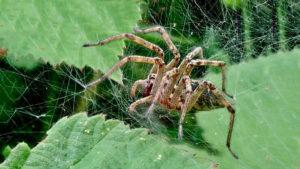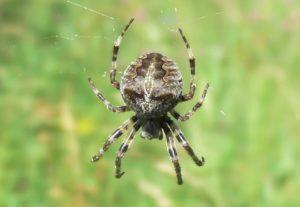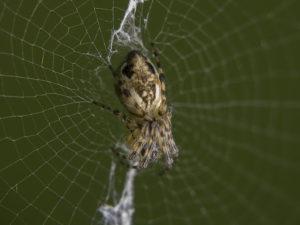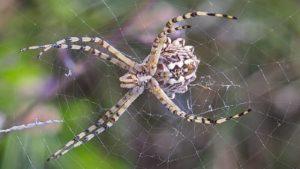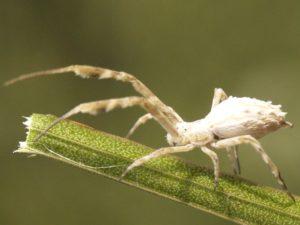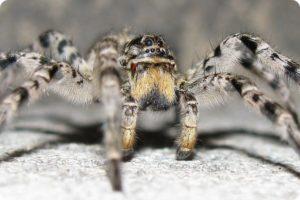What spiders are found in the Volgograd region
The Volgograd region is located in the northern part of the Southern Federal District, and most of its territory is occupied by steppes and semi-deserts. Such conditions are best suited for the development of small rodents, birds, reptiles, insects and spiders.
Content
What types of spiders live in the Volgograd region
The fauna of the Volgograd region includes more than 80 species arachnids. Among them there are both dangerous, poisonous species, and completely harmless ones.
labyrinth spider
This species belongs to the family funnel spiders and it is also often referred to as the labyrinthine agelena. Their body length reaches only 12-14 mm. The abdomen is most often colored brown, and the cephalothorax may have a yellowish or reddish tint. All limbs and body of the spider are densely covered with gray hairs.
Representatives of this species most often settle in grass thickets in open, well-lit areas. The poison that labyrinth spiders produce is completely harmless to humans and can only cause pain and slight redness at the bite site.
Angled cross
This view crosses is rare and in some countries even listed in the Red Book. A distinctive feature of this species is the humps on the sides of the abdomen and the absence of a characteristic light pattern in the shape of a cross on the back. The length of the largest individuals can reach 15-20 mm.
Angled crosses spend most of their time on their trapping nets, waiting for prey. The bite of spiders of this species is dangerous only for small animals and insects. For humans, their poison is practically harmless and can only cause short-term pain and redness.
Cyclose conical
These spiders are members of the genus of crosses from the family spinners. They got their name due to the characteristic cone-shaped abdomen. The body size of the largest female of conical cyclose does not exceed 7-8 mm. Due to the fact that these spiders are very small, they are not capable of harming humans.
An interesting feature of this species is their predilection for collecting a strip from the corpses of their victims and other debris in the center of their web. They use the collected remains of insects as shelter.
Agriopa
Two of the brightest representatives of this genus live on the territory of the Volgograd region - Agriope Brunnich and Agriope lobata. The body length of these spiders can be from 5 to 15 mm. A characteristic feature of the brünnich agriope is the striped color of yellow-black. The lobed agriope stands out from other packs due to the special notches on the abdomen.
Like other species from the family of orb-weavers, agriopes weave round nets and spend almost all the time on their surface in anticipation of a victim. These spiders do not show aggression towards humans, but in self-defense they can bite. The poison of this species can be dangerous for allergy sufferers, and in a healthy person it often causes unpleasant symptoms.
black fathead
The scientific name of this species is black eresus. These are tiny spiders with a very bright appearance. Their length is only 8-16 mm. The legs and cephalothorax of the fathead are black, and the abdomen is bright red and decorated with four round spots.
Representatives of this species are most often found in dense thickets of grass or shrubs, in well-lit areas. The poison of the black eresus is practically harmless to humans and can only cause slight swelling, redness and pain at the site of the bite.
Uloborus walckenaerius
These are small-sized arthropods that are part of the feather-footed spider family. Their body length ranges from 4 to 6 mm. The limbs, cephalothorax and abdomen are colored in dark and light shades of brown, and covered with white hairs. A feature of this species is that the front pair of limbs is developed much better than others.
Uloborid spiders live in meadows and glades with low vegetation. They build their web in a horizontal position, and almost all the time they are on its surface. Spiders of this species are completely harmless to humans.
South Russian tarantula
Another common name for this spider is mizgir. These are well-known representatives of the genus of tarantulas. Their body length is about 25-30 mm, and the color is dominated by shades of gray and brown.
Tarantulas do not weave trapping nets and prefer active hunting. Mizgiri live in burrows up to 40 cm deep. The bite of spiders of this species is not fatal for a healthy person, but can cause severe swelling, redness and burning pain.
Karakurt
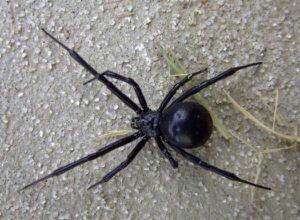 Karakurt - a member of the web spider family is the most dangerous arachnid in the Volgograd region. The size of the female can reach 15-20 mm. The belly of the karakurt is smooth, black and decorated with 13 red spots.
Karakurt - a member of the web spider family is the most dangerous arachnid in the Volgograd region. The size of the female can reach 15-20 mm. The belly of the karakurt is smooth, black and decorated with 13 red spots.
You can meet this spider in open glades, wastelands and slopes of ravines. The poison they produce is toxic to humans. Without timely seeking medical help, a bite of a karakurt can lead to serious consequences for health and even human life.
Conclusion
Despite the pronounced continentality in the climate of the Volgograd region, dangerous animals can be found on its territory. poisonous spiders, which are habitual inhabitants of the tropics and subtropics. Therefore, local residents and tourists visiting this region should be careful and attentive, especially during outdoor recreation.
